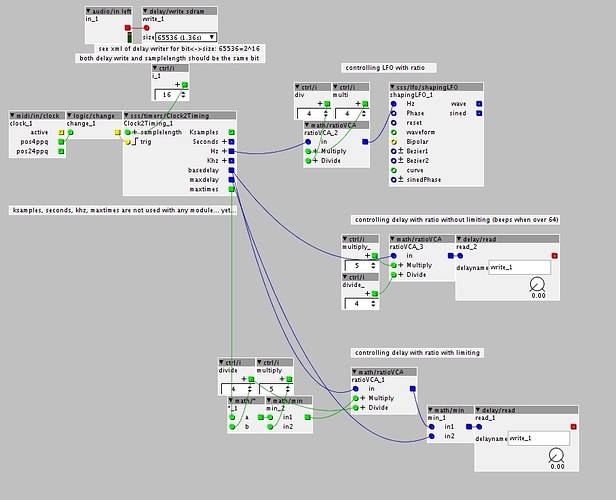If you would like to make a donation for my services, you can donate using this link:
paypal.me/SirSickSik
I started coding my first modules three weeks ago and I like it! XD
So, here comes the list:
CONV:
-pitch2khz (actual khz value)
DIST:
-analogue: analogue style distortion with a "capacitor" holding the maximum energy that can be used for gain (gain takes energy from it, feed adds energy to it)
DYN:
-transien designer: dynamics module for adding/subtracting volume to/from the attack or decay parts of the incoming sound.
-compressor: compressor with attack/decay, threshold (oh now I notice I completely forgot the ratio hahaha), input gain, expander function and goal-gain.
-limiter: limiter with decaytime, threshold, automakeup gain and expander function
FILTER:
-36dB LP filter with resonance
FX:
-pitchshifter: with LFO-rate and window size
LFO:
-ShapingLFO: low frequency oscillator with selectable sine,tri,saw,ramp,pulse waveforms, phase input, reset/sync, uni/bipolar option, 2x bezier-curve parameters, curve mode (normal,exp,-exp, S-curve peak, S-curve Square) and extra harmonics input.
-latchfader: outputs a trigger each time the sine is at lower (trg 2) or upper (trg 1) bound. Usable for triggering latch module and the morph from one to the other using mixfader controlled by the sine output.
LOGIC:
-Shift register: CV/gate 32-step shift register with loop-position selection and 3 combi outputs for gates (trigger position selected by var inputs)
MATH:
-8x smooth: 1 control for smoothing 8 values at the same time.
-divremc: with a range input instead as attribute.
-divremcgates: each time rem is at selected countposition, outputs a high gate,
-ratioVCA: uses integers to set a division for an incoming float.
-tripplepower: 3x stacked exponential curves. Usable for curving the phase of an oscillator for example.
MUX:
-modselector: features 8 inputs for modulations and 8 outputs to send to. Has input-selectors and volume control for each output.
-smthRotator: smoothly rotates the 8 inputs over the 8 outputs.
OSC (&shapers):
-11XShaper: MASSIVE phasor-oscillator shaper with 11 modes (one glitching between the 10 main modes). Each mode has 6 parameters to modulate the waveform. CPU range from 5% to up to 17% for the harmonic morphing shaper!
-3AMshape: 3 sine oscillator ringmodulating each other. 6 parameters to control
-3xModOsc: tripple sine oscillator with FM, PM and AM.
-6HrmShape: heavy harmonic shaper. Shapes incoming phase into 6 seperate sines morphing from one harmonic to another.
-doublepulsar: pulsewidth oscillator with 2x2 cores.
-dualbezshape: bezier oscillator with 2 stacked bezier curves. One for positioning the curve and the other for the curve-amount.
-glitch osc: based on my counter modules, this just glitches the hell out of the phase input, jumping, wrapping, speeding up etc.
-ringosc: ringmod oscillator for creating bell-like tones.
-sawtrimod: oscillator with controls for morphing the waveform. Saw<-tri->rampl, tri<->sine, pulse etc..
-supersaw: supersaw oscillator with 6 parameter controls for detuning, pitch offset, phase, morphrate.
-vosimshaper: a vowel oscillator using 3 AM'd sine oscillator each having their own rate control (in ratio to incoming phase) and width control.
PATT:
-1RngCount: single counter manipulator based around the divremc module (which I've been calling ranger module for several years now in my synthedit projects). Incoming count gets ranged between 0 and Pre-Range. After this the rem-out gets multiplied, added to the multiplied div-out and added to a multiplied (div-out)*(rem-out). Hard to explain, but very usable for quick patterns.
-CountMem: Module for using a single knob and single selector for controlling the 9 parameters of the 4RngCounter or 3 single counters.
-ReCntMem: controller module for the ReCount module, needing only a single control, to control up to 16 parameters.
-ReCntPos: a counter "restarter" or polyrhythmic generator. For up to 16 steps, set the count-length that each step takes before going to the next step.
-countCtrl: controller module for the Countmem module, showing which parameter is being selected.
TABLE:
-16mod_recorder: record up to 16 modulations with just a single selector and single CV control!
TIMERS:
-Clock2Timing: converts a clock/gate signal into timing references. Outputs total amount of samples for each tick, seconds, Hz to be used with my LFO modules, khz for bpm-synced oscillators (if you'ld like that), base-delay time to be used for BPM synced delays, maxdelay for bouding the delay-modulation to usable range, and "maxtimes": the amount of times the basedelay time can be multiplied and still fit the delaybuffer.
The samplelength input should be set to the same binary value of the delay module (see values in xml code by opening in editor)


